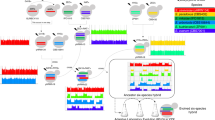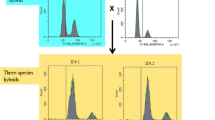Abstract
IN general, a heterocaryon between a white and a yellow mutant of Aspergillus fungi gives rise to white, yellow, and green progeny. It was found recently, however, that five heterocaryons produced between two of the seven colour mutants of A. sojae strain K could give brown progeny besides the white, yellow, and green. Evidence that the brown strain appears to be a heterocaryon possessing haploid and diploid nuclei in a common cytoplasm is to be described.
This is a preview of subscription content, access via your institution
Access options
Subscribe to this journal
Receive 51 print issues and online access
$199.00 per year
only $3.90 per issue
Buy this article
- Purchase on Springer Link
- Instant access to full article PDF
Prices may be subject to local taxes which are calculated during checkout
Similar content being viewed by others
References
Ishitani, C., and Sakaguchi, K., J. Gen. and App. Microbiol., 2, 345 (1956).
Ishitani, C., and Sakaguchi, K., J. Gen. and App. Microbiol., 1, 283 (1955).
Ishitani, C., Uchida, K., and Ikeda, Y., Exp. Cell Res., 10, 737 (1956).
Ishitani, C., Ikeda, Y., and Sakaguchi, K., J. Gen. and App. Microbiol., 2, 401 (1956).
Pontecorvo, G., Adv. in Genetics, 5, 141 (1953).
Author information
Authors and Affiliations
Rights and permissions
About this article
Cite this article
TAKEICHI, C., IKEDA, Y. A Heterocaryon possessing Haploid and Diploid Nuclei. Nature 192, 1317–1318 (1961). https://doi.org/10.1038/1921317a0
Issue Date:
DOI: https://doi.org/10.1038/1921317a0
Comments
By submitting a comment you agree to abide by our Terms and Community Guidelines. If you find something abusive or that does not comply with our terms or guidelines please flag it as inappropriate.



